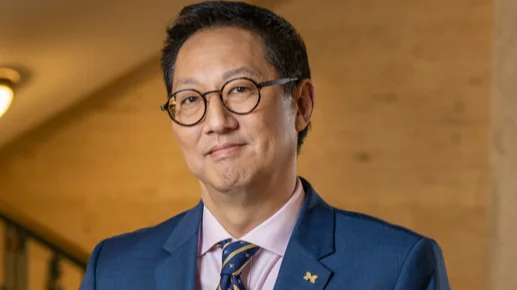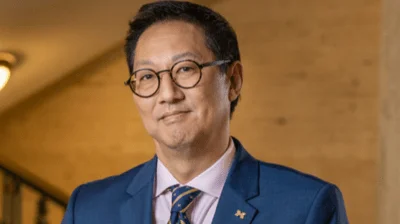Santa J. Ono, Ph.D. President at University of Michigan - Ann Arbor | Official website
Santa J. Ono, Ph.D. President at University of Michigan - Ann Arbor | Official website
A research team led by the University of Michigan is working to reduce lag in virtual and augmented reality (VR and AR) games designed for rehabilitation. The project, supported by a $3.5 million grant from the National Science Foundation over two years, brings together core partners from Duke University, Columbia University, and Nokia Bell Labs, along with collaborators at the University of Southern California and Microsoft Research.
The goal is to make these games as responsive as possible for players. In such systems, information must travel quickly between players’ wearable devices, local 5G base stations, and cloud-hosted virtual worlds before returning to both players and therapists. Achieving near real-time responsiveness is essential for an immersive experience but remains challenging due to network limitations.
Two games are central to the project’s research. One is an adaptive soccer game developed by iGYM L.L.C., a startup linked to the University of Michigan. This game allows both wheelchair users and able-bodied players to participate together by kicking or timing their kicks with a button press. The current version operates in gyms equipped with projectors and tracking systems, but researchers hope that VR and AR enhancements will allow remote participation from home or enable teams in different cities to compete.
The second game, WordPlay—developed at USC—is intended for people with Parkinson’s disease. Players walk across an animated deck collecting letter blocks while navigating obstacles, which provides both physical activity and cognitive engagement. It also offers opportunities for social interaction with friends or therapists in a digital environment.
The research team plans three approaches to address latency issues: improving how game code compensates for lag; developing methods for mapping internet traffic routes efficiently; and optimizing data transfer within play spaces so critical actions are prioritized for rapid updates.
Jiasi Chen, associate professor of electrical and computer engineering at U-M and lead principal investigator on the project, explained: “If you’re playing a soccer game, for example, then you need really low latency. Especially if you want people to play at different locations, it has to be very reactive and fast. Even if you’re playing a slower game—if there’s lag between touching something and moving it, that won’t feel good to the user,” Chen said
“Hopefully, our system will be very fast and responsive, almost as if all players were in the same room.”
Key contributors include Maria Gorlatova from Duke University co-leading one area of research alongside nursing and therapy experts at Duke and USC; Ethan Katz-Bassett from Columbia leading another focus area; Nakjung Choi from Nokia Bell Labs overseeing work on networked systems; and James Finley from USC managing development related to Parkinson’s rehabilitation.
The first demonstration of this technology is expected at U-M in June 2026. By the end of the funding period, simultaneous demonstrations are planned at Duke University in Durham, North Carolina, and Nokia Bell Labs campus in Murray Hill, New Jersey.
The University of Michigan holds a financial interest in iGYM L.L.C., which developed one of the key games involved in this project.






 Alerts Sign-up
Alerts Sign-up